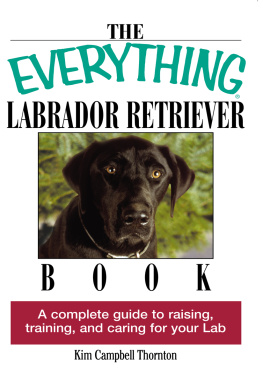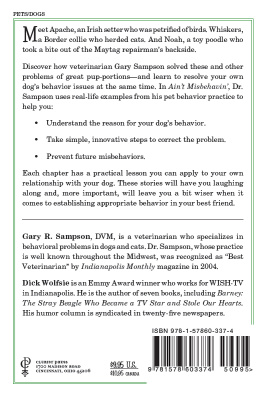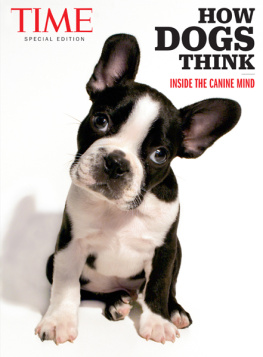June Kikuchi, Editorial Director
Roger Sipe, Special Projects Editor
Karen Julian, Publishing Coordinator
Elizabeth Spurbeck, Assistant Editor
Jerome Callens, Art Director
Jessica Jaensch, Production Supervisor
Tracy Burns, Production Coordinator
Copyright 2004, 2009 by I-5 Press
Cavalier King Charles Spaniel cover by Seth Casteel/www.littlefriendsphoto.com Interior photos by Seth Casteel/www.littlefriendsphoto.com (pages 6, 13, 17, 18, 20, 25, 23, 24, 28, 43, 48, 53, 57, 63), Isabelle Francais/I-5 Publishing, LLC, and Gina Cioli and Pamela Hunnicutt/I-5 Publishing, LLC
All rights reserved. No part of this book may be reproduced, stored in a retrieval system, or transmitted in any form or by any means, electronic, mechanical, photocopying, recording or otherwise, without the prior written permission of I-5 Press, except for the inclusion of brief quotations in an acknowledged review.
Library of Congress Catalog Card Number: 96-80216
ISBN: 1-889540-01-3
eISBN: 9781620080559
I-5 Press
A Division of I-5 Publishing, LLC
3 Burroughs, Irvine, California 92618
Printed and bound in China.
15 14 13 12 11 10 09 3 4 5 6 7 8 9 10
Why Do Dogs
BEHAVIORAL BYTES
FIDO FACTOIDS
The Basics of Barking
Dogs bark because they have something to say. Barking may sound just like noise to us, but to dogs, barks actually say a lot of things:
That guy in the blue uniform is attacking our front door again!
A strange car has pulled into the driveway!
Help! Ive stuck my head through a hole in the fence, and I cant get out.
Hey! Youve been home for five minutes, and you havent said hello to me yet.
FIDO FACTOID Dogs have been barking for a long time. More than 10,000 years ago, wild dogs hung around peoples caves, scrounging for leftovers and trying to sneak in when it rained (sound familiar?). These traits were passed on to generations until eventually some dogs lost their wild side, a process called domestication. One of the results of domestication is that dogs have kept many puppy-like characteristics, including barking. For example, adult wild dogs, such as wolves, coyotes and foxes, bark very little, but their puppies bark a lot.
Dogs communicate with us in many ways, and barking is one way they can get their point across. A dogs bark can warn us of danger or when they need help.
Dogs bark when they get excited and sometimes just for the fun of it. When you yell at them to stop, they get even more excited. Cool! My owners barking back at me. Now we can have a real conversation. To a dog, any kind of attention even yelling is something to celebrate. 


Car Wars
All day long, your dog tears off after the motorized monsters, barking and snapping at the tires. As each vehicle pulls away, he happily turns back with a satisfied expression. Score: Dog 5, Cars 0. Car chasing is generally a territorial reaction, often aimed at cars or trucks that drive by regularly, such as postal trucks or delivery vans.
Car chasing can also be a form of predatory behavior, usually triggered by noise and motion. Frustrated herding dogs frequently engage in predatory car chasing. After all, the herding instinct is nothing but a redirected form of the prey drive, in which the dog circles and drives his prey but does not follow through with the kill. Such an ingrained behavior can be difficult to change, but its not impossible. 
BEHAVIORAL BYTE As with most training, patience and consistency are key. If your dog chases particular vehicles (the neighbors or mail carriers), try a couple of methods.
If your dog doesnt know the drivers, ask them to stop by for an introduction. If your dog gets to know them, especially if they give her a treat, she will be less likely to view them and their vehicles as trespassers.
Another way to curtail car chasing is to regularly exercise your dog away from her territory. Go for long walks or hikes, play a fast and furious game of Frisbee in the park or go jogging on the beach.
These are the friendly methods. Should they fail, you may need to take more drastic and time-consuming steps, like working with a personal trainer.
Dogs vs. Cats

For thousands of years, dogs and cats have been painted as sworn enemies. Now, those of us who live with both cats and dogs know that they usually get along just fine; but, as with most myths and misconceptions, there is a kernel of truth to the war saga between the canines and the felines.
Both dogs and cats, wild and domesticated, are natural predators mighty hunters of the natural world. Despite their long history as pets, the prey drive is often triggered by motion. This is especially true for sighthounds such as Greyhounds or Salukis; terriers bred to hunt small animals such as rats and moles; and sporting breeds, all of whom were bred for the hunt.
Even though dogs of these breeds may live in a city or suburb and never hunt, instinct kicks in when a cat (or squirrel or rabbit) flashes past. The quick movement attracts the dogs attention, inciting him to chase. For some dogs, the fun is in the chase. In others, however, the prey drive is so powerful that the dog carries it through to its logical conclusion: the death of the animal being chased, if caught. This is common in breeds that have a strong hunting instinct but no outlet for their innate behaviors.

BEHAVIORAL BYTE If your dog loves to chase cats, there are some things you can try to put the brakes on her bad habit. Keep the dog on leash, even in the house if necessary, until the situation is under control. When your dog tries to go after a cat, redirect her attention to a favorite ball or toy. Playtime with the special toy should be limited to when cats are around.
Sometimes the substitution of a toy isnt enough. If your dog continues to try to chase cats, give her a leash correction or use an unpleasant sound to break her concentration. When her attention is focused on you instead of the cat, reward her. Your dog must learn that running after cats equals trouble; ignoring them brings good things. Never let your dog stare intently at a cat either; again, correct her by saying no or by using unpleasant noise.
Sometimes, dogs seem to differentiate between cats in the house (off limits) and cats outside (fair game). How the cat reacts is important, too. A cat who stands his ground and hisses or swipes at the dog is far more likely to escape than one who runs. Faced with a spitting, scratching cat, a smart dog will often turn tail.
We all know from experience that its difficult to change a habit especially a bad one. Changing the instinctive habit of a dog is equally difficult but can sometimes be done. Patience, consistency and sometimes the help of a trainer or behaviorist are necessary. 
Next page



















